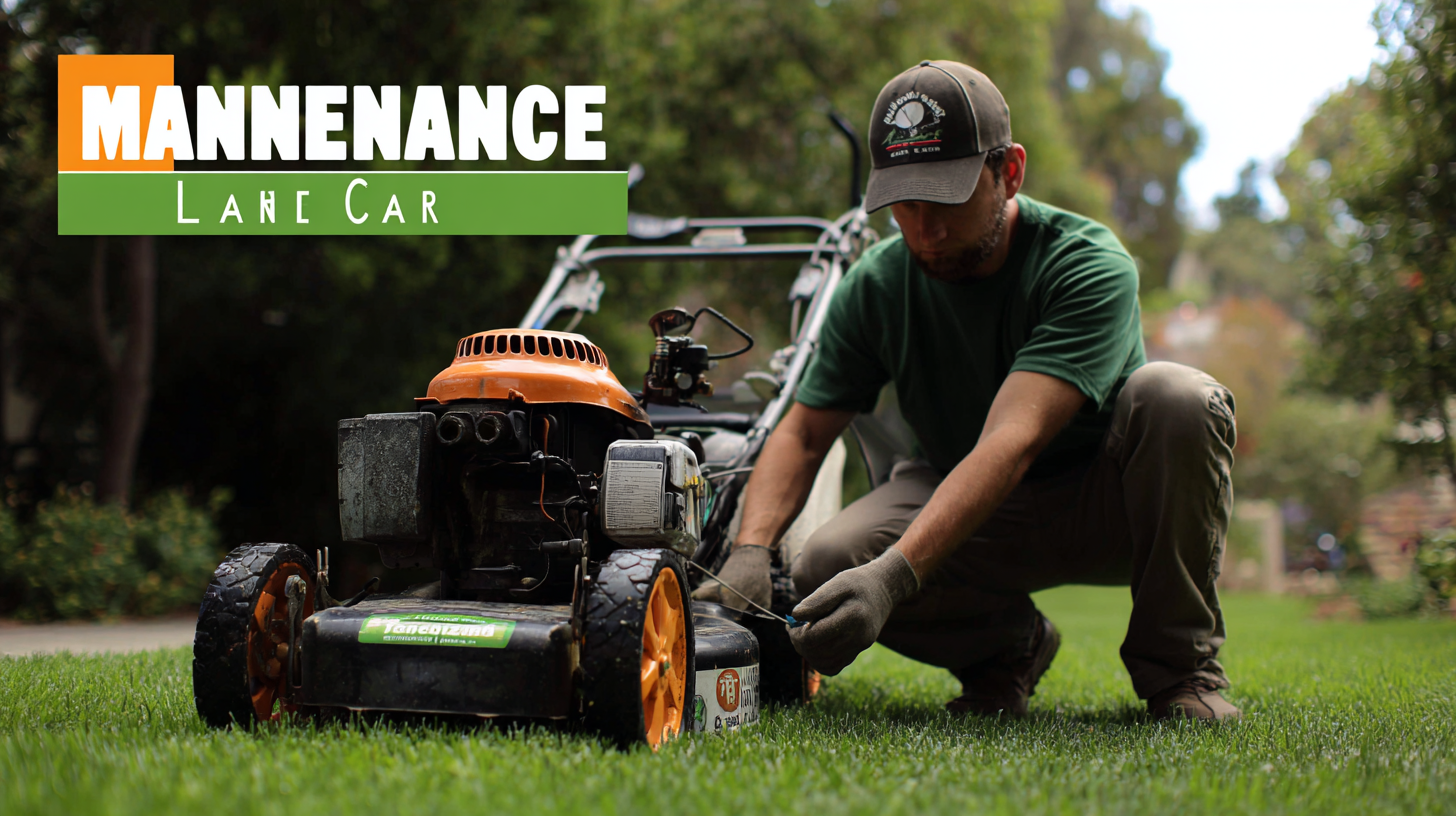Blog
Signature Lawn and Landscape LLC
Exploring 2025 Innovations in Best Maintenance Lawn Care Techniques for a Greener Future
As we step into 2025, the urgency for sustainable practices in various sectors becomes more pronounced, particularly in Maintenance Lawn Care, which plays a crucial role in creating environmentally friendly landscapes. According to the 2021 National Lawn Care Report, the lawn care services industry is projected to reach a market value of $21.08 billion by 2027, reflecting a growing demand for innovative solutions that prioritize sustainability.

Recent strides in technology, such as precision irrigation systems and biodegradable lawn care products, promise to revolutionize traditional practices, reducing water waste and chemical runoff. By integrating these 2025 innovations, maintenance lawn care not only enhances the aesthetic appeal of our outdoor spaces but also contributes significantly to ecological preservation, fostering a greener future for generations to come.
Innovative Lawn Maintenance Technologies Transforming After-Sales Service in 2025
As we head into 2025, the lawn care industry is experiencing a revolutionary shift fueled by innovative technologies that are enhancing after-sales services. Smart maintenance solutions, such as AI-driven lawn analysis tools, allow homeowners to monitor their yard's health in real time. These tools can detect issues like pests, diseases, or nutrient deficiencies, prompting timely interventions and ensuring a lush green lawn. Moreover, with the integration of customer relationship management (CRM) systems, service providers can now offer tailored maintenance schedules based on individual lawn conditions, leading to more personalized care.

Additionally, the rise of automated equipment, such as robotic mowers and drone-assisted lawn treatments, is making lawn care more efficient than ever. These technologies not only reduce the labor-intensive tasks associated with lawn maintenance but also provide precise and timely services to customers. For example, drones equipped with spray technology can deliver nutrients directly to the areas that need them most, cutting down on waste and promoting eco-friendly practices. In this evolving landscape, after-sales support has also embraced technology, with customers enabled to schedule appointments, track service history, and provide feedback effortlessly through user-friendly apps. This level of engagement fosters a stronger relationship between service providers and clients, setting new standards for customer satisfaction in the lawn care industry.
Cost-Effective Solutions for Sustainable Lawn Care Maintenance
As we look forward to 2025, the demand for sustainable yet cost-effective lawn care solutions is on the rise. Traditional lawn maintenance practices often involve high costs and environmental concerns, but innovative techniques are emerging to provide greener alternatives. One such method is the implementation of smart irrigation systems that optimize water usage based on real-time weather data, significantly reducing water waste. Homeowners can enjoy healthy, lush lawns without incurring exorbitant water bills, making this both an eco-friendly and economically sound choice.

Additionally, using organic fertilizers and natural pest control methods offers a dual benefit of enhancing lawn health while being gentle on the environment. These sustainable solutions not only promote biodiversity but also minimize chemical runoff, ultimately contributing to a healthier ecosystem.
Investing in native plant landscaping can further reduce maintenance costs, as these plants require less water and are more resilient to local pests and diseases. Embracing these innovations in lawn care can lead to a greener future that aligns with both ecological responsibility and financial prudence.
Case Studies: Successful Implementation of Smart Lawn Care Systems
As we delve into the advancements shaping lawn care in 2025, one of the most compelling trends is the integration of smart technologies. Case studies show that successful implementation of smart lawn care systems can significantly reduce water usage and improve efficiency. For instance, a report by the Irrigation Association states that smart irrigation systems can reduce water consumption by up to 30%, which not only conserves resources but also leads to healthier lawns.
A notable case is the city-wide adoption of automated turf management in San Diego, where sensors monitor soil moisture and weather conditions to optimize watering schedules. This innovation has resulted in a 40% decrease in water wastage and a dramatic improvement in grass health. Homeowners can also benefit from similar technologies; investing in soil moisture sensors can empower you to make informed decisions about when and how much to water, ensuring vibrant lawns while conserving precious resources.
Tip: When implementing smart lawn care solutions, start small with a programmable timer for your irrigation system to better manage your watering times. Consider also using drone technology for aerial assessments of your lawn health, which can provide insights that help reduce pesticide use and improve overall lawn care practices.
Innovations in Lawn Care Techniques for a Greener Future (2025)
This chart illustrates the adoption rates of various innovative lawn care techniques projected for 2025. Smart irrigation leads as the most adopted method, while drones for maintenance show a noteworthy, yet lower adoption rate. These innovations are crucial for achieving a greener future in lawn care.
Eco-Friendly Practices in Lawn Maintenance: Balancing Cost and Environmental Impact
The demand for eco-friendly practices in lawn maintenance is rapidly rising, driven by growing environmental awareness and the desire for sustainable landscaping. According to a 2022 report from the Environmental Protection Agency, traditional lawn care techniques contribute to nearly 70 million pounds of chemical fertilizers and herbicides used annually in the U.S. alone. By adopting eco-friendly alternatives, homeowners can significantly reduce their carbon footprint and enhance local biodiversity. For instance, switching to organic fertilizers can decrease nitrogen runoff, which is linked to harmful algal blooms in freshwater ecosystems.
Furthermore, innovative technologies are changing the way we manage lawns with a focus on sustainability. Smart irrigation systems, which utilize sensors and weather data, can reduce water consumption by up to 50%, as noted in a study by the Water Research Foundation. Implementing practices such as xeriscaping or using native plants not only conserves water but also minimizes maintenance costs over time.
Investing in these eco-friendly options not only benefits the environment but also leads to long-term financial savings, making them a win-win proposition for homeowners and the planet alike.
The Future of Lawn Care: Predictions and Innovations for Enhanced Service Efficiency
The global lawn care machinery market is on the brink of significant growth, driven by increasing urbanization and the relentless pursuit of greener spaces. Industry forecasts suggest that the market for robotic lawn mowers alone will leap from $1.48 billion in 2021 to an impressive $4.04 billion by 2028, marking a compound annual growth rate (CAGR) of 15.5%. This surge reflects a mounting demand for innovative lawn care solutions that enhance efficiency while minimizing environmental impact.
As cities expand, the importance of green spaces becomes paramount for enhancing urban landscapes and improving the quality of life for residents. The strategic development of urban green areas not only bolsters a city’s aesthetic appeal but also plays a crucial role in promoting ecological balance. Innovations in lawn care technology, particularly within automated solutions, are set to transform the way we maintain these essential outdoor spaces, paving the way for a more sustainable future. As businesses adapt to these changing needs, the integration of advanced technologies will undoubtedly streamline services and foster a greener environment.
Exploring 2025 Innovations in Best Maintenance Lawn Care Techniques for a Greener Future
| Innovation | Description | Expected Impact | Implementation Year |
|---|---|---|---|
| Smart Irrigation Systems | Automated systems that adjust watering schedules based on weather conditions and soil moisture. | Reduced water consumption and healthier lawns. | 2025 |
| Eco-Friendly Fertilizers | Organic fertilizers that promote soil health and reduce chemical runoff. | Minimization of environmental impact and enhanced grass growth. | 2025 |
| GPS Lawn Mowing Technology | Robotic mowers using GPS for precise lawn mowing and efficiency. | Improved service efficiency and reduced labor costs. | 2025 |
| Sustainable Grass Varieties | Development of grass types that require less water and maintenance. | Lower resource use and easier lawn care. | 2025 |
| Drone Technology for Lawn Health Monitoring | Drones equipped with sensors to assess lawn health and spot issues early. | Proactive maintenance and reduced resources needed for recovery. | 2025 |


Share On: